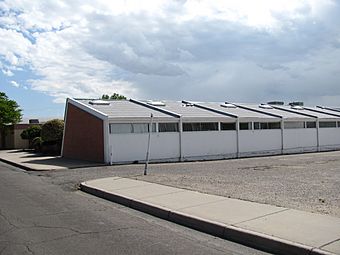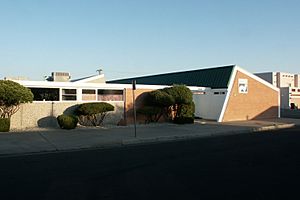Solar Building facts for kids
|
Solar Building
|
|

Solar Building, May 2010
|
|
| Location | 213 Truman St. NE, Albuquerque, New Mexico |
|---|---|
| Built | 1956 |
| Architect | Stanley & Wright |
| NRHP reference No. | 89001589 |
Quick facts for kids Significant dates |
|
| Added to NRHP | October 10, 1989 |
The Solar Building in Albuquerque, New Mexico is super special! It was the world's very first office building to get most of its heat from the sun. It was built in 1956 for an engineering company called Bridgers & Paxton. They designed the amazing solar heating system themselves.
This new building got a lot of attention. It was featured in popular magazines like Life and Popular Mechanics. Later, in the 1970s, scientists studied it with money from the National Science Foundation. The Solar Building was added to important lists of historic places. It joined the New Mexico State Register of Cultural Properties in 1985. Then, in 1989, it was added to the National Register of Historic Places. This was only 33 years after it was built!
Contents
Building History: A Sunny Idea
The company Bridgers & Paxton Consulting Engineers started in 1951. It was founded by Frank Bridgers and Donald Paxton. Both men were very interested in using solar energy for buildings. They first worked out of a garage.
They soon thought of building a new office. This office would have an experimental solar heating system. They believed this system would save money. It would also help them learn more about solar power for future projects. In 1954, they tried some of their ideas. They designed a heating and cooling system for the Simms Building. This building used its south-facing glass walls to help heat it in winter. But it still needed more heating or cooling most of the time.
Designing the Solar Building
Bridgers and Paxton started designing the Solar Building in early 1954. Construction began in March 1956 and finished in August 1956. Stanley & Wright were the architects for the building. The total cost was $58,500. The special heating and cooling system cost about $15,000. This was about twice the cost of a normal heating system. But Bridgers and Paxton thought it would save money on energy bills later.
The unique building became very famous. It was written about in many national magazines. These included Architectural Forum, Life, and Popular Mechanics. This building even inspired other solar heating systems built later.
Solar System Challenges and Comeback
The building's heating system worked well for six years. It even worked during a very cold and cloudy January in 1957. That month only had three sunny days! However, it didn't save as much money as they hoped. This was because fuel was very cheap back then.
In 1962, the building was made bigger. The solar collector system was replaced with a regular boiler. But the old solar equipment was left in place. This turned out to be a smart move! A few years later, the 1973 oil crisis happened. This made people very interested in solar energy again. The Solar Building became famous once more.
In 1974, a researcher named Stanley Gilman got a grant. He was from Penn State. He used the money to fix the building's solar heating system. He then studied it for several years. This study helped figure out the best ways to design solar systems. After the study, the solar heating system continued to be used.
Bridgers & Paxton eventually needed a bigger office. They moved to a new place in 1985. The Solar Building was recognized as important history. It was added to the New Mexico State Register of Cultural Properties in 1985. Then, it joined the National Register of Historic Places in 1989. It was considered "exceptionally significant" even though it was only 33 years old.
Building Design: International Style
The Solar Building is a one-story building. It is built in the International Style. This style often uses clean lines and simple shapes. The building has two main parts.
The north part held the main design room. It also had the solar heating equipment. This part of the building has an unusual shape. Its roof and south wall are angled. This helps the solar collectors get more sunlight. The north wall has a long, thin row of windows. These windows let light into the design room. The east side, facing the street, is made of brick with no windows.
The south part of the building has a flat roof. It holds office spaces. Part of it is covered in brick. This shows where the original building ended. An addition was built in 1962. The main entrance is where the two parts of the building meet.
How the Heating System Works
The building's solar heating system was very clever. It used 56 solar thermal collectors. These collectors covered an area of 800 square feet (74 m2). They were placed on a south-facing wall. This wall was angled at 30 degrees. This angle helped them catch the most sunlight in winter.
The collectors were special aluminum panels. They had channels inside for water to flow through. The surface of each collector was painted black. This helped it absorb the most heat. A layer of glass covered the collectors. This trapped the heat inside, like a mini-greenhouse.
Heating the Building
On sunny days, water flowing through the collectors would get very hot. It could reach 140 °F (60 °C)! This hot water was then stored in a huge 6,000-gallon tank. This tank was underground and insulated. It could store enough hot water for up to three cloudy days.
Most of the time, the water in the tank was warm enough to heat the building directly. It was pumped through special panels in the floor and ceiling. If the tank water got too cool, a heat pump would help. A heat pump is like a refrigerator, but it moves heat instead of cold. It would take heat from the cooler water in the tank. Then it would send that heat to the panels in the building. The heat pump could work as long as the tank water was above 35 °F (2 °C).
Cooling the Building
In summer, the system could also cool the building. It would circulate cold water instead of hot. The storage tank would hold cold water. This helped save energy. It could store heat during the day and release it at night when it was cooler.
Most of the time, an evaporative cooler kept the water in the tank cool. If the water got too warm, the heat pump would turn on. It would move heat out of the cold water and into the tank. The system could even cool the building during the day. At the same time, it could store hot water from the solar collectors to heat the building at night.
System Improvements
Over time, some small changes were made to the system. One early problem was that the collector panels started to rust. The original panels had water channels built right into them. When leaks appeared, these channels were replaced. New copper tubing was attached to the back of the panels instead.
In the 1970s, Stanley Gilman made more changes. He changed the liquid in the collector loop to ethylene glycol. This liquid is like antifreeze and stopped the water from freezing. He also re-soldered the collector panels. This helped them transfer heat better. Gilman also added an automatic control system. He updated the air system too. This allowed each office to control its own temperature. Even with these changes, the system still works mostly as it was first designed.


